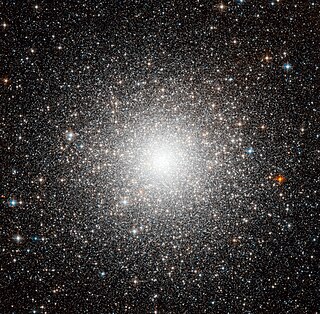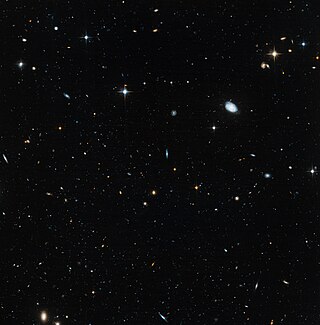Related Research Articles

A globular cluster is a spheroidal conglomeration of stars that is bound together by gravity, with a higher concentration of stars towards its center. It can contain anywhere from tens of thousands to many millions of member stars, all orbiting in a stable, compact formation. Globular clusters are similar in form to dwarf spheroidal galaxies, and the distinction between the two is not always clear. Their name is derived from Latin globulus. Globular clusters are occasionally known simply as "globulars".

Spiral galaxies form a class of galaxy originally described by Edwin Hubble in his 1936 work The Realm of the Nebulae and, as such, form part of the Hubble sequence. Most spiral galaxies consist of a flat, rotating disk containing stars, gas and dust, and a central concentration of stars known as the bulge. These are often surrounded by a much fainter halo of stars, many of which reside in globular clusters.

The Sagittarius Dwarf Spheroidal Galaxy (Sgr dSph), also known as the Sagittarius Dwarf Elliptical Galaxy, is an elliptical loop-shaped satellite galaxy of the Milky Way. It contains four globular clusters in its main body, with the brightest of them—NGC 6715 (M54)—being known well before the discovery of the galaxy itself in 1994. Sgr dSph is roughly 10,000 light-years in diameter, and is currently about 70,000 light-years from Earth, travelling in a polar orbit at a distance of about 50,000 light-years from the core of the Milky Way. In its looping, spiraling path, it has passed through the plane of the Milky Way several times in the past. In 2018 the Gaia project of the European Space Agency showed that Sgr dSph had caused perturbations in a set of stars near the Milky Way's core, causing unexpected rippling movements of the stars triggered when it moved past the Milky Way between 300 and 900 million years ago.

Messier 54 is a globular cluster in the constellation Sagittarius. It was discovered by Charles Messier in 1778 and then included in his catalog of comet-like objects.

A dwarf spheroidal galaxy (dSph) is a term in astronomy applied to small, low-luminosity galaxies with very little dust and an older stellar population. They are found in the Local Group as companions to the Milky Way and as systems that are companions to the Andromeda Galaxy (M31). While similar to dwarf elliptical galaxies in appearance and properties such as little to no gas or dust or recent star formation, they are approximately spheroidal in shape and generally have lower luminosity.
The Canis Major Overdensity or Canis Major Dwarf Galaxy is a disputed dwarf irregular galaxy in the Local Group, located in the same part of the sky as the constellation Canis Major.

Willman 1 is an ultra low-luminosity dwarf galaxy or a star cluster. Willman 1 was discovered in 2004. It is named after Beth Willman of Haverford College, the lead author of a study based on the Sloan Digital Sky Survey data. The object is a satellite of the Milky Way, at ~120,000 light-years away. Willman 1 has an elliptical shape with the half-light radius of about 25 pc. Its heliocentric velocity is approximately −13 km/s.
Canes Venatici I or CVn I is a dwarf spheroidal galaxy situated in the Canes Venatici constellation and discovered in 2006 in the data obtained by Sloan Digital Sky Survey. It is one of the most distant known satellites of the Milky Way as of 2011 together with Leo I and Leo II. The galaxy is located at a distance of about 220 kpc from the Sun and is moving away from the Sun at a velocity of about 31 km/s. It is classified as a dwarf spheroidal galaxy (dSph) meaning that it has an elliptical shape with the half-light radius of about 550 pc.
Ursa Major II Dwarf is a dwarf spheroidal galaxy situated in the Ursa Major constellation and discovered in 2006 in the data obtained by the Sloan Digital Sky Survey. The galaxy is located approximately 30 kpc from the Sun and moves towards the Sun with the velocity of about 116 km/s. It has an elliptical shape with the half-light radius of about 140 pc.
Segue 1 is a dwarf spheroidal galaxy or globular cluster situated in the Leo constellation and discovered in 2006 by Sloan Digital Sky Survey. It is located at a distance of about 23 kpc from the Sun and moves away from the Sun with the velocity of about 206 km/s. Segue 1 has a noticeably elongated shape with the half-light radius of about 30 pc. This elongation may be caused by the tidal forces acting from the Milky Way galaxy if Segue 1 is being tidally disrupted now.

Leo IV is a dwarf spheroidal galaxy situated in the Leo constellation, discovered in 2006 in the data obtained by the Sloan Digital Sky Survey. The galaxy is located at the distance of about 160 kpc from the Sun and moves away from the Sun with the velocity of about 130 km/s. It is classified as a dwarf spheroidal galaxy (dSph) meaning that it has an approximately round shape with the half-light radius of about 130 pc.
Leo V is a dwarf spheroidal galaxy situated in the Leo constellation and discovered in 2007 in the data obtained by the Sloan Digital Sky Survey. The galaxy is located at a distance of about 180 kpc from the Sun and moves away from the Sun with the velocity of about 173 km/s. It is classified as a dwarf spheroidal galaxy (dSph) meaning that it has an approximately spherical shape with the half-light radius of about 130 pc.
Canes Venatici II or CVn II is a dwarf spheroidal galaxy situated in the Canes Venatici constellation and discovered in 2006 in data obtained by the Sloan Digital Sky Survey. The galaxy is located at a distance of about 150 kpc from the Sun and moves towards the Sun with the velocity of about 130 km/s. It is classified as a dwarf spheroidal galaxy (dSph) meaning that it has an elliptical shape with a half-light radius of about 74+14
−10 pc.
Coma Berenices or Com is a dwarf spheroidal galaxy situated in the Coma Berenices constellation and discovered in 2006 in data obtained by the Sloan Digital Sky Survey. The galaxy is located at the distance of about 44 kpc from the Sun and moves away from the Sun with the velocity of about 98 km/s. It is classified as a dwarf spheroidal galaxy (dSph) meaning that it has an elliptical shape with the half-light radius of about 70 pc.
Boötes II or Boo II is a dwarf spheroidal galaxy situated in the constellation Boötes and discovered in 2007 in the data obtained by Sloan Digital Sky Survey. The galaxy is located at the distance of about 42 kpc from the Sun and moves towards the Sun with the speed of 120 km/s. It is classified as a dwarf spheroidal galaxy (dSph) meaning that it has an approximately round shape with the half-light radius of about 51 pc.

Hercules, or Her, is a dwarf spheroidal galaxy situated in the Hercules constellation and discovered in 2006 in data obtained by the Sloan Digital Sky Survey. The galaxy is located at a distance of about 140 kpc from the Sun and moves away from the Sun with a velocity of about 45 km/s. It is classified as a dwarf spheroidal galaxy (dSph). It has a noticeably elongated shape with a half-light radius of about 350 pc. This elongation may be caused by tidal forces acting from the Milky Way galaxy, meaning that Her is being tidally disrupted now. Her also shows some gradient of velocities across the galaxy's body and is embedded into a faint stellar stream, which also points towards its ongoing tidal disruption.
Boötes III is an overdensity in the Milky Way's halo, which may be a disrupted dwarf spheroidal galaxy. It is situated in the constellation Boötes and was discovered in 2009 in the data obtained by Sloan Digital Sky Survey. The galaxy is located at the distance of about 46 kpc from the Sun and moves away from it at the speed of about 200 km/s. It has an elongated shape with the radius of about 0.5 kpc. The large size and an irregular shape may indicate that Boötes III in a transitional phase between a gravitationally bound galaxy and completely unbound system.
Pisces II is a dwarf spheroidal galaxy situated in the Pisces constellation and discovered in 2010 in the data obtained by the Sloan Digital Sky Survey. The galaxy is located at the distance of about 180 kpc (kiloparsecs) from the Sun. It is classified as a dwarf spheroidal galaxy (dSph) meaning that it has an elongated shape with the half-light radius of about 60 pc and ratio of the axis of about 5:3.
Leo T is a dwarf galaxy situated in the Leo constellation and discovered in 2006 in the data obtained by Sloan Digital Sky Survey. The galaxy is located at the distance of about 420 kpc from the Sun and moves away from the Sun with the velocity of about 35 km/s. The velocity with respect to the Milky Way is around −60 km/s implying a slow infall onto the Milky Way. Leo T is classified as a transitional object between dwarf spheroidal galaxies (dSph) and dwarf irregular galaxies (dIrr). Its half-light radius is about 180 pc.
The Eridanus II Dwarf is a low-surface brightness dwarf galaxy in the constellation Eridanus. Eridanus II was independently discovered by two groups in 2015, using data from the Dark Energy Survey. This galaxy is probably a distant satellite of the Milky Way. Eridanus II contains a centrally located globular cluster; and is the smallest, least luminous galaxy known to contain a globular cluster. Crnojević et al., 2016. Eridanus II is significant, in a general sense, because the widely accepted Lambda CDM cosmology predicts the existence of many more dwarf galaxies than have yet been observed. The search for just such bodies was one of the motivations for the ongoing Dark Energy Survey observations. Eridanus II has special significance because of its apparently stable globular cluster. The stability of this cluster, near the center of such a small, diffuse, galaxy places constraints on the nature of dark matter.
References
- 1 2 3 "NAME Segue 2". SIMBAD . Centre de données astronomiques de Strasbourg . Retrieved 2016-08-24.
- 1 2 3 4 5 6 7 Belokurov, V.; Walker, M.G.; Evans, N.W.; et al. (2009). "Segue 2: A Prototype of the Population of Satellites of Satellites". Mon. Not. R. Astron. Soc. 397 (4): 1748–1755. arXiv: 0903.0818 . Bibcode:2009MNRAS.397.1748B. doi: 10.1111/j.1365-2966.2009.15106.x . S2CID 20051174.
